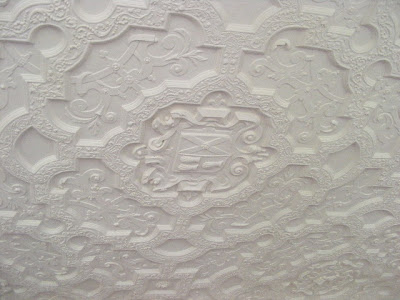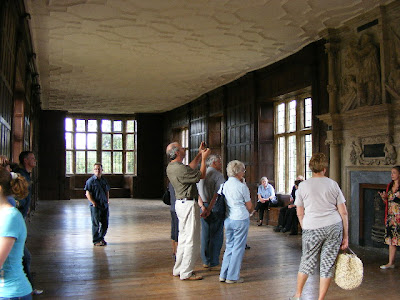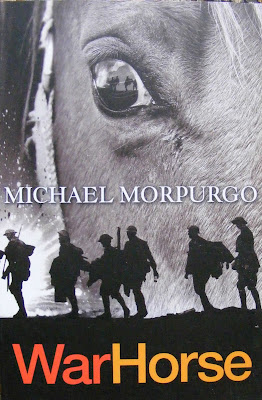Apethorpe
A couple of weekends ago we went to Apethorpe: until quite recently this was a large and unknown house unless you lived in Northamptonshire and knew through the local news of its chequered history - I didn't realise until we came that the Borstal to which one of my acquaintances was sent was probably here, nor that Porterhouse Blue was filmed here. For years, we had seen tantalising glimpses but never seen it properly. Now that English Heritage have bought it and spent a huge wodge of money on it to stabilise it, you can visit it, albeit only in the summer, and if you want to go you'll have to hurry, as the season ends on 5th September.
It is the most absolutely enchanting house. OH and I decided that if we had a spare £50 million (£5 million to buy it, another £12 million to carry on restoration, plus the rest to meet the enormous annual running costs and no doubt vast programme of annual maintenance) we'd buy it like a shot. It's the sort of house you'd never get to the bottom of: quite literally - there's at least 100 rooms. It is now on a deeply undomestic scale: three courtyards, one of which has the state rooms, another more accomodation and a third what looks to be general storage. There are no services actually connected, and the programme of restoration still to be done is huge.
The roof alone was so complicated to restore that the builders in the end had to keep a compass up there so they knew which range they were supposed to be working on, having repaired the wrong one. It was a great privilege to see the sheer quality of work that English Heritage have done. The roof walk lets you see the Collyweston slate and repaired dormers as close as you like and it is mouth-watering. So very often you see bodged repairs to historical buildings by people who seem to resent the need to care for the building, and to see if done absolutely as it should be is fantastic.
The mechanics of actually living in the house would be interesting: you'd need mobile phones so that you'd be able to find your nearest and dearest, and I could see a life of being continually late because you couldn't track everyone down. You'd probably have to insist on a daily briefing each morning, and make sure watches were synchronised to have any chance of making sure everyone was where they were supposed to be. I can foresee a whole new career for the retrieving dog: you'd need to keep a trained pack of them to hunt down the teenager reluctant to make that vital family visit.
Anyway, you are allowed to photograph, so I did. The tour only covers the courtyard containing the state rooms, as the other two courtyards are not safe. First you get to see what is of course of abiding interest to me, the stableyard. Alas this was converted to staff accommodation during the house's days as a Borstal, and none of the original stable fittings survive. At this point I have to confess I was busily drawing up mental plans for restoring the stables as a first priority, involving perhaps a sort of museum of stables through the ages, and thinking to myself what a very interesting research project that would be...... however, moving rapidly on, English Heritage recently demolished a modern addition to the stables, and found this:

He had been preserved by the modern building: thankfully, as much of Apethorpe was vandalised and many fittings stolen while it was uninhabited. He dates from the 1600s, and was put there by the Mildmay family, who owned the hall. His off hind was found in a blocked up window: the off fore still hasn't turned up.
Apethorpe's earliest extant buildings are Medieval:


This (I think - I got geographically bamboozled after a bit) is what was the Medieaval Great Hall, and here is a detail, showing the condition most of the place is still in:

It's details like this that make the place so absolutely fascinating: everywhere you look, there are more and more of them.


It is the most absolutely enchanting house. OH and I decided that if we had a spare £50 million (£5 million to buy it, another £12 million to carry on restoration, plus the rest to meet the enormous annual running costs and no doubt vast programme of annual maintenance) we'd buy it like a shot. It's the sort of house you'd never get to the bottom of: quite literally - there's at least 100 rooms. It is now on a deeply undomestic scale: three courtyards, one of which has the state rooms, another more accomodation and a third what looks to be general storage. There are no services actually connected, and the programme of restoration still to be done is huge.
The roof alone was so complicated to restore that the builders in the end had to keep a compass up there so they knew which range they were supposed to be working on, having repaired the wrong one. It was a great privilege to see the sheer quality of work that English Heritage have done. The roof walk lets you see the Collyweston slate and repaired dormers as close as you like and it is mouth-watering. So very often you see bodged repairs to historical buildings by people who seem to resent the need to care for the building, and to see if done absolutely as it should be is fantastic.
The mechanics of actually living in the house would be interesting: you'd need mobile phones so that you'd be able to find your nearest and dearest, and I could see a life of being continually late because you couldn't track everyone down. You'd probably have to insist on a daily briefing each morning, and make sure watches were synchronised to have any chance of making sure everyone was where they were supposed to be. I can foresee a whole new career for the retrieving dog: you'd need to keep a trained pack of them to hunt down the teenager reluctant to make that vital family visit.
Anyway, you are allowed to photograph, so I did. The tour only covers the courtyard containing the state rooms, as the other two courtyards are not safe. First you get to see what is of course of abiding interest to me, the stableyard. Alas this was converted to staff accommodation during the house's days as a Borstal, and none of the original stable fittings survive. At this point I have to confess I was busily drawing up mental plans for restoring the stables as a first priority, involving perhaps a sort of museum of stables through the ages, and thinking to myself what a very interesting research project that would be...... however, moving rapidly on, English Heritage recently demolished a modern addition to the stables, and found this:

He had been preserved by the modern building: thankfully, as much of Apethorpe was vandalised and many fittings stolen while it was uninhabited. He dates from the 1600s, and was put there by the Mildmay family, who owned the hall. His off hind was found in a blocked up window: the off fore still hasn't turned up.
Apethorpe's earliest extant buildings are Medieval:


This (I think - I got geographically bamboozled after a bit) is what was the Medieaval Great Hall, and here is a detail, showing the condition most of the place is still in:

It's details like this that make the place so absolutely fascinating: everywhere you look, there are more and more of them.


This is a detail of what is now one of the back doors. Goodness knows how many ways there are in and out of the house: they must be legion.


Apethorpe has some (relatively) recent additions: this square block is a south-facing conservatory put on (possibly - I should have taken notes) in the 19th century by a previous owner for his wife, who suffered badly from arthritis. She survived into her eighties, so the room must have done her some good.

The state rooms were constructed for the visits of James I, together with, initially, a joining door between the King's bedroom and that of his favourite, the Duke of Buckingham. The fireplaces in the state rooms are a particular glory of Apethorpe:


The ceilings in the state rooms have been restored: the water leaking in through the failing roofs meant they were perilously close to collapse, but they are now magnificent:


Although English Heritage have spent £4 million, there is still an enormous amount to do: and that is before you consider anything like bathrooms and a working kitchen. That it survived as well as it did is testament to its (unpaid for many years) caretaker, Mr Kelley.





Apethorpe has some (relatively) recent additions: this square block is a south-facing conservatory put on (possibly - I should have taken notes) in the 19th century by a previous owner for his wife, who suffered badly from arthritis. She survived into her eighties, so the room must have done her some good.

The state rooms were constructed for the visits of James I, together with, initially, a joining door between the King's bedroom and that of his favourite, the Duke of Buckingham. The fireplaces in the state rooms are a particular glory of Apethorpe:


The ceilings in the state rooms have been restored: the water leaking in through the failing roofs meant they were perilously close to collapse, but they are now magnificent:
At the top of the state rooms is a roof walk, which is apparently where you would take exercise (though perhaps not your over-exhuberant pack), or perhaps watch the King hunting. It is up here that you get the closest look at the brilliance of the restoration:


Although English Heritage have spent £4 million, there is still an enormous amount to do: and that is before you consider anything like bathrooms and a working kitchen. That it survived as well as it did is testament to its (unpaid for many years) caretaker, Mr Kelley.



Outside, although there is the Leylandii hedge, belonging to a previous owner - and frankly I feel I could live with it if I had the rest of the house and grounds to look at -

there is a rather splendid dovecote:

and the gardens are wonderful: very little in the way of flower, but they don't really need it. The pool below was used as an outdoor swimming pool during the house's Borstal days: apparently the boys, with great good taste, far preferred this pool to their purpose-built modern one. The house was pretty much self-sufficient then, and the boys were taught trades, one of which was horticulture.



I hope Apethorpe is lived in by the sort of person who has immensely deep pockets allied with a completely pervasive respect for history and who is prepared to make compromises in their own personal comfort in order to live with the house, but I suspect there are not too many of them about. Perhaps Prince Charles would like to take it on as a very personal statement of how he sees the preservation of beauty. Apethorpe would make a fine palace. Take a video tour here.
More on Apethorpe and its caretaker here.
Update on Apethorpe: 2012

there is a rather splendid dovecote:

and the gardens are wonderful: very little in the way of flower, but they don't really need it. The pool below was used as an outdoor swimming pool during the house's Borstal days: apparently the boys, with great good taste, far preferred this pool to their purpose-built modern one. The house was pretty much self-sufficient then, and the boys were taught trades, one of which was horticulture.



I hope Apethorpe is lived in by the sort of person who has immensely deep pockets allied with a completely pervasive respect for history and who is prepared to make compromises in their own personal comfort in order to live with the house, but I suspect there are not too many of them about. Perhaps Prince Charles would like to take it on as a very personal statement of how he sees the preservation of beauty. Apethorpe would make a fine palace. Take a video tour here.
More on Apethorpe and its caretaker here.
Update on Apethorpe: 2012




Comments
Do you know any more about the unpaid caretaker?
CMM - thanks!
Gillian - it is a very beautiful place. I'm not sure whether the exterior of the medieaval part was Elizabethanized or not. It's possible.
Brothmark@comsouth.net